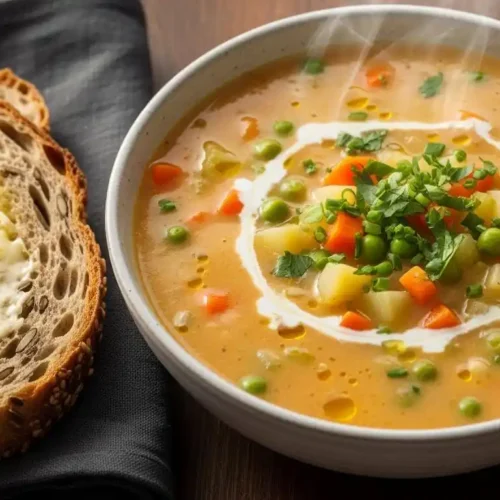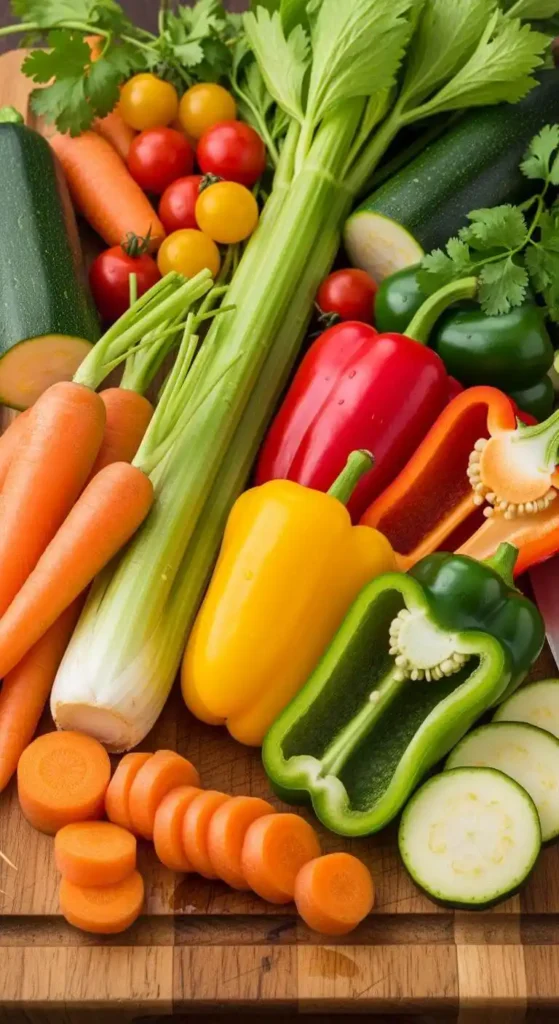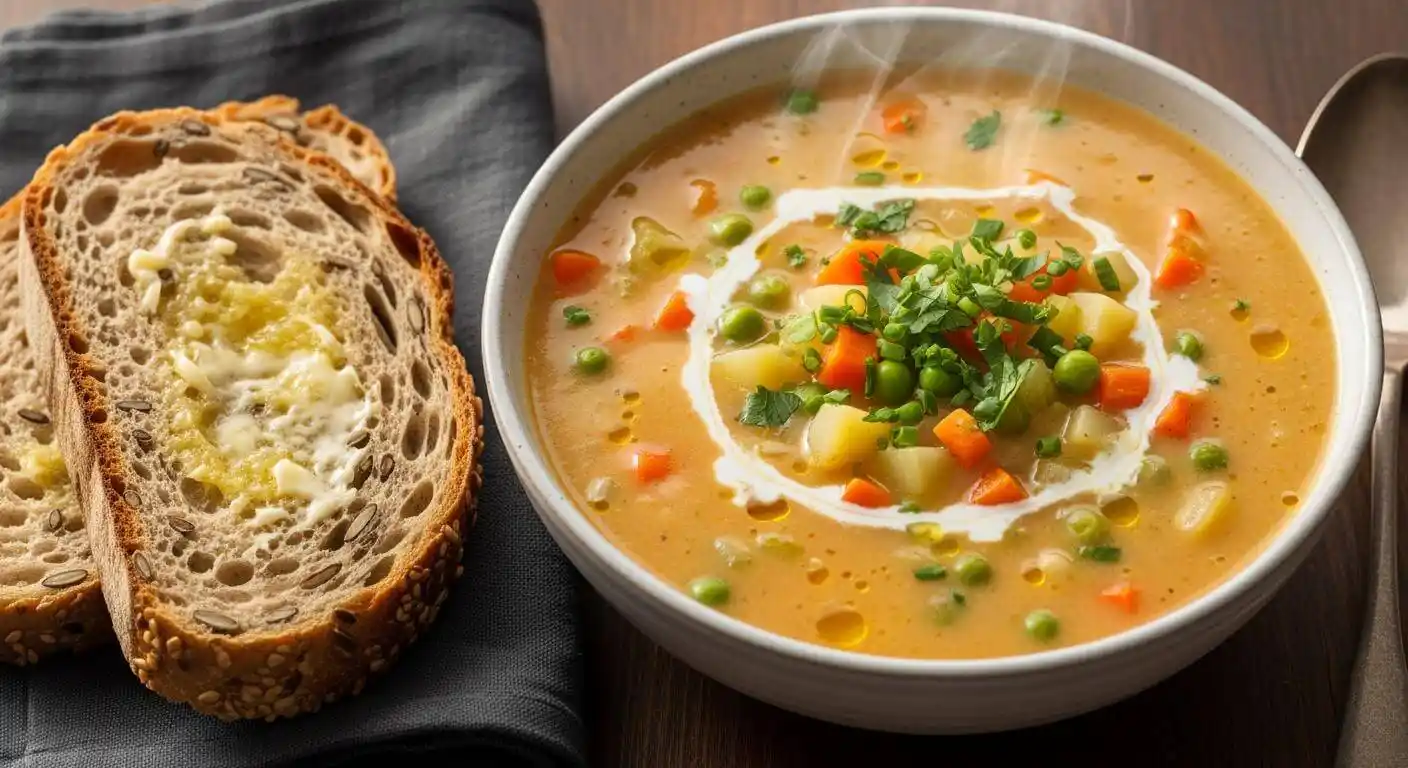Welcome to a bowl of warmth and comfort! This Vegetable Soup is not only creamy and delicious but also packed with nutritious ingredients that will nourish your body and soul. Whether you’re looking for a wholesome meal to enjoy on a chilly evening or a light yet satisfying dish for lunch, this soup is the perfect choice. It’s incredibly versatile, allowing you to customize it with your favorite seasonal vegetables and herbs. Moreover, it’s a fantastic way to sneak in those essential vitamins and minerals while keeping your meal low-calorie and heart-healthy. So, gather your fresh vegetables and let’s dive into this delightful recipe that promises to be both comforting and fulfilling!
Table of Contents
Table of Contents

Vegetable Soup
Equipment
- 1 Large saucepan For cooking the soup.
- 1 immersion blender Optional, for blending the soup.
Ingredients
Fresh Vegetables
- 2 cups Carrots Chopped.
- 1 cup Celery Chopped.
- 1 cup Bell peppers Chopped.
- 1 cup Zucchini Chopped.
- 2 medium Potatoes Diced.
Aromatics
- 1 medium Onion Chopped.
- 2 cloves Garlic Minced.
Liquid Base
- 4 cups Vegetable broth High-quality for best flavor.
- 1 cup Coconut cream Optional for creaminess.
Seasoning
- 1 teaspoon Salt To taste.
- 1 teaspoon Pepper To taste.
- 2 tablespoons Nutritional yeast For cheesy flavor.
- 1 tablespoon Fresh parsley Chopped, for garnish.
- 1 teaspoon Fresh thyme Chopped.
Instructions
Gather Your Ingredients
- Start by collecting fresh vegetables such as carrots, celery, potatoes, and any seasonal produce you love. Additionally, have vegetable broth, herbs, and spices ready.
Prep the Vegetables
- Chop your vegetables into uniform pieces. This ensures even cooking. For a time-saving tip, consider using pre-chopped veggies from your local grocery store.
Sauté the Base
- In a large saucepan, heat a splash of olive oil over medium heat. Add chopped onions and garlic, sautéing until fragrant. This step builds a flavorful base for your vegetable soup.
Add the Vegetables
- Next, toss in your chopped vegetables. Stir them for about 5 minutes. This helps to enhance their flavors before adding the broth.
Pour in the Broth
- Now, add your vegetable broth to the pot. Ensure the vegetables are fully submerged. If you prefer a thicker soup, use less broth.
Season to Taste
- Season your soup with salt, pepper, and herbs like thyme or parsley. Remember, you can always adjust the seasoning later, so start with a little and add more as needed.
Simmer
- Bring the soup to a gentle boil, then reduce the heat and let it simmer for about 20-30 minutes. This allows the flavors to meld beautifully.
Blend for Creaminess
- If you desire a creamy texture, use an immersion blender to blend part of the soup. Alternatively, transfer a portion to a blender, then return it to the pot. This adds a delightful creaminess without using dairy.
Taste and Adjust
- Before serving, taste your vegetable soup. Adjust the seasoning if necessary. If it feels a bit bland, a splash of lemon juice can brighten the flavors.
Serve and Enjoy
- Ladle the soup into bowls and garnish with fresh herbs or a sprinkle of nutritional yeast for added flavor. Pair it with whole-grain bread for a complete meal.
Notes
| Calories | Fat | Protein | Carbs |
|---|---|---|---|
| 150 | 5g | 3g | 25g |
Key Benefits
Vegetable soup is not just a comforting dish; it’s a powerhouse of health benefits that can elevate your meals. Here’s why you should consider adding this nutritious option to your diet:
- Rich in Nutrients: Vegetable soup is packed with vitamins and minerals. Each bowl is a delightful mix of fresh vegetables, providing essential nutrients that support your overall health.
- Low-Calorie Comfort: If you’re looking for a satisfying meal without the guilt, vegetable soup is your go-to. It’s low in calories yet filling, making it perfect for those mindful of their weight.
- Immune-Boosting Properties: Thanks to the variety of vegetables, this soup is rich in antioxidants. These compounds help strengthen your immune system, keeping you healthy, especially during cold seasons.
- Heart-Healthy: Many ingredients in vegetable soup, such as leafy greens and beans, contribute to heart health. They are low in saturated fats and high in dietary fiber, which can help lower cholesterol levels.
- Hydration Benefits: With a base of broth or water, vegetable soup is an excellent way to stay hydrated. This is particularly important during hot weather or after exercise.
- Supports Digestion: The fiber content in vegetable soup aids digestion. It helps keep your gut healthy and can prevent constipation.
- Versatile and Customizable: You can easily tailor vegetable soup to your taste. Whether you prefer a creamy texture or a chunky style, the possibilities are endless!
In summary, vegetable soup is not only a delicious comfort food but also a wholesome choice that supports your health. So, why not whip up a batch today? You’ll enjoy the flavors and reap the benefits!
Ingredients for a Wholesome Vegetable Soup
Creating a delightful Vegetable Soup begins with selecting the freshest ingredients. This is where the magic happens! Below is a list of essential components that will elevate your soup to new heights:
- Fresh Vegetables: Choose a colorful array, such as carrots, celery, bell peppers, and zucchini. These not only add flavor but also provide essential vitamins and minerals.
- Onion and Garlic: These aromatic staples are crucial for building a robust flavor base. Sauté them until they’re fragrant, and you’ll be on your way to a delicious soup.
- Potatoes: For a heartier texture, diced potatoes are perfect. They add creaminess and help thicken the soup naturally.
- Vegetable Broth: Opt for a high-quality vegetable broth to infuse your soup with depth. Alternatively, you can use water, but broth enhances the flavor significantly.
- Cream Substitute: If you desire a creamy texture, consider using coconut cream or a splash of almond milk. These options are not only dairy-free but also add a unique twist.
- Herbs and Spices: Fresh herbs like parsley and thyme will brighten your soup. Additionally, a pinch of salt and pepper will enhance the overall flavor profile.
- Nutritional Yeast: For a cheesy flavor without dairy, sprinkle in some nutritional yeast. It’s packed with nutrients and adds a savory depth.

When selecting your ingredients, remember that freshness is key. Seasonal vegetables not only taste better but also contribute to a more nutritious Vegetable Soup. Furthermore, feel free to customize based on what you have on hand or your dietary preferences. For instance, if you’re looking for a gluten-free option, ensure your broth meets that requirement. In essence, the ingredients you choose will set the stage for a comforting, heart-healthy meal that’s both satisfying and nourishing.
How to Make Vegetable Soup
Making a delicious and nutritious vegetable soup is easier than you might think. Follow these simple steps to create a comforting bowl of goodness that’s both satisfying and low in calories.
- Gather Your Ingredients: Start by collecting fresh vegetables such as carrots, celery, potatoes, and any seasonal produce you love. Additionally, have vegetable broth, herbs, and spices ready.
- Prep the Vegetables: Chop your vegetables into uniform pieces. This ensures even cooking. For a time-saving tip, consider using pre-chopped veggies from your local grocery store.
- Sauté the Base: In a large saucepan, heat a splash of olive oil over medium heat. Add chopped onions and garlic, sautéing until fragrant. This step builds a flavorful base for your vegetable soup.
- Add the Vegetables: Next, toss in your chopped vegetables. Stir them for about 5 minutes. This helps to enhance their flavors before adding the broth.
- Pour in the Broth: Now, add your vegetable broth to the pot. Ensure the vegetables are fully submerged. If you prefer a thicker soup, use less broth.
- Season to Taste: Season your soup with salt, pepper, and herbs like thyme or parsley. Remember, you can always adjust the seasoning later, so start with a little and add more as needed.
- Simmer: Bring the soup to a gentle boil, then reduce the heat and let it simmer for about 20-30 minutes. This allows the flavors to meld beautifully.
- Blend for Creaminess: If you desire a creamy texture, use an immersion blender to blend part of the soup. Alternatively, transfer a portion to a blender, then return it to the pot. This adds a delightful creaminess without using dairy.
- Taste and Adjust: Before serving, taste your vegetable soup. Adjust the seasoning if necessary. If it feels a bit bland, a splash of lemon juice can brighten the flavors.
- Serve and Enjoy: Ladle the soup into bowls and garnish with fresh herbs or a sprinkle of nutritional yeast for added flavor. Pair it with whole-grain bread for a complete meal.

By following these steps, you’ll have a wholesome vegetable soup ready in no time. Enjoy the comforting flavors and the health benefits of this nutritious dish!
Pro Tips, Variations, and Common Problems
Creating the perfect vegetable soup is a delightful journey, and with a few chef secrets, you can elevate your dish to new heights. Here are some pro tips to ensure your vegetable soup is both delicious and satisfying.
Customization
Vegetable soup is incredibly versatile. You can customize it based on your preferences or what you have on hand. For example:
- Use seasonal vegetables for the freshest flavors. Carrots, zucchini, and bell peppers are excellent choices.
- If you want a heartier soup, add beans or lentils for extra protein and fiber.
- For a creamier texture, consider blending a portion of the soup and then mixing it back in.
Ingredient Swaps
Don’t have all the ingredients? No problem! Here are some easy swaps:
- Instead of vegetable broth, use water with a splash of soy sauce or miso for added depth.
- For a dairy-free option, substitute cream with coconut milk or almond milk.
- If you’re out of fresh herbs, dried herbs can work too; just remember to use them sparingly, as they are more concentrated.
Common Problems and Solutions
Even the best chefs encounter issues. Here’s how to troubleshoot common problems:
- Overcooked Vegetables: If your vegetables are mushy, try adding fresh ones at the end of cooking to maintain some texture.
- Lack of Flavor: If your soup tastes flat, add a splash of lemon juice or a dash of hot sauce to brighten it up.
- Too Thick: If your soup is thicker than desired, simply stir in more broth or water until you reach your preferred consistency.
By following these tips, you’ll create a vegetable soup that is not only comforting but also bursting with flavor. Enjoy the process, and remember, cooking is all about experimenting and finding what works best for you!
Serving Suggestions for Vegetable Soup
Vegetable soup is not just a dish; it’s a warm embrace in a bowl. Traditionally, it is served as a comforting starter or a hearty main course. To elevate your vegetable soup experience, consider these delightful serving suggestions:
Garnishes
Garnishing your vegetable soup can transform it into a visual masterpiece. Fresh herbs, such as parsley or cilantro, add a pop of color and freshness. Additionally, a drizzle of olive oil or a sprinkle of nutritional yeast can enhance the flavor profile. For a touch of crunch, consider adding homemade croutons or toasted seeds.
Accompaniments
Pairing your vegetable soup with the right accompaniments can create a well-rounded meal. Whole-grain bread or a crusty baguette is perfect for dipping. Furthermore, a light salad with a citrus vinaigrette complements the soup beautifully, adding a refreshing contrast.
Meal Prep Ideas
Vegetable soup is a fantastic option for meal prep. You can prepare a large batch and store it in airtight containers. This makes it easy to grab a nutritious lunch during the week. Moreover, consider serving it with a side of whole-grain crackers for added texture and flavor.
Lunch Ideas
For a quick and satisfying lunch, serve your vegetable soup in a thermos. This keeps it warm and ready to enjoy. Additionally, you can pair it with a simple sandwich, such as hummus and veggie wraps, for a balanced meal.
In conclusion, serving vegetable soup is all about creativity and personal touch. Whether you choose to garnish it with fresh herbs or pair it with crusty bread, these suggestions will surely impress your guests and make your meal memorable.
Preserving and Reheating Vegetable Soup
Storing your delicious Vegetable Soup properly is essential to maintain its vibrant flavors and comforting texture. To begin with, always allow the soup to cool completely before transferring it to an airtight container. This step is crucial because it prevents condensation, which can lead to spoilage. For refrigeration, your Vegetable Soup will stay fresh for about 3 to 4 days. If you want to keep it longer, freezing is an excellent option. In fact, when stored in a freezer-safe container or vacuum-sealed bag, it can last up to 3 months. However, remember to label your containers with the date, so you can keep track of freshness.
Food safety is paramount, so make sure to refrigerate or freeze the soup within two hours of cooking. Additionally, always check for any signs of spoilage, such as off smells or unusual textures, before consuming. If you notice any changes, it’s best to err on the side of caution and discard the soup.
Reheating Methods
When it comes to reheating your Vegetable Soup, there are several methods to choose from, each preserving the soup’s delightful taste and texture. The stovetop is often the best choice, as it allows for even heating. Simply pour the soup into a saucepan and heat it over medium-low heat. Stir occasionally to ensure it warms evenly. If the soup appears too thick, you can add a splash of vegetable broth or water to refresh it.
Alternatively, the microwave is a quick option. Transfer the soup to a microwave-safe bowl, cover it loosely with a microwave-safe lid or plate, and heat in 1-minute intervals, stirring in between. This method helps prevent hot spots and ensures the soup heats evenly. If you prefer using an air fryer, place the soup in an oven-safe dish and reheat at 350°F (175°C) for about 10-15 minutes, stirring halfway through.
Regardless of the method you choose, always reheat your Vegetable Soup to a minimum temperature of 165°F (74°C) to ensure it’s safe to eat. By following these simple steps, you can enjoy your Vegetable Soup just as much as the first time you made it, full of flavor and warmth!
Conclusion
As we wrap up this delightful journey into making creamy vegetable soup, I hope you feel inspired to bring this wholesome meal into your kitchen. This recipe is not only easy to follow but also incredibly versatile, allowing you to customize it with your favorite seasonal vegetables. Whether you’re looking for a nutritious choice for a cozy dinner or a satisfying dish to share with family, this vegetable soup is sure to please. So, why not give it a try? I would love to hear your thoughts, so please feel free to comment below or share your results!
Encouragement to Experiment
Remember, cooking is all about creativity and fun. Don’t hesitate to experiment with different herbs, spices, or even add a splash of lemon juice for a zesty twist. Additionally, consider pairing your soup with crusty whole-grain bread or a fresh salad for a complete meal. The possibilities are endless, and I encourage you to make this recipe your own!
In conclusion, making vegetable soup is not just about nourishing your body; it’s also about enjoying the process and sharing love through food. So, gather your ingredients, roll up your sleeves, and dive into this comforting culinary adventure. Happy cooking!
Frequently Asked Questions about Vegetable Soup
Welcome to our FAQ section! Here, we address some common questions about making and enjoying Vegetable Soup. Whether you’re a seasoned chef or a beginner, we hope these answers help you create a delicious bowl of comfort.
1. Can I use frozen vegetables in my Vegetable Soup?
Absolutely! Frozen vegetables are a great time-saver and can be just as nutritious as fresh ones. Just remember to adjust the cooking time, as frozen veggies may require less time to cook through.
2. How can I make my Vegetable Soup thicker?
If you prefer a thicker texture, consider adding a few diced potatoes or using a thickening agent like cornstarch. Simply mix a tablespoon of cornstarch with a little water, then stir it into the soup while it simmers. This will help achieve that creamy consistency.
3. What herbs and spices work best in Vegetable Soup?
Herbs like thyme, parsley, and basil can elevate the flavor of your Vegetable Soup. Additionally, spices such as black pepper and paprika add warmth. Feel free to experiment with your favorites to create a unique flavor profile!
4. How long can I store leftover Vegetable Soup?
You can store leftover Vegetable Soup in an airtight container in the refrigerator for up to 4 days. For longer storage, consider freezing it. Just make sure to leave some space in the container, as the soup will expand when frozen.
5. Is Vegetable Soup suitable for a vegan diet?
Yes, Vegetable Soup is naturally vegan! Just ensure that your broth is plant-based, and you can enjoy a wholesome, hearty meal that fits perfectly into a vegan lifestyle.

